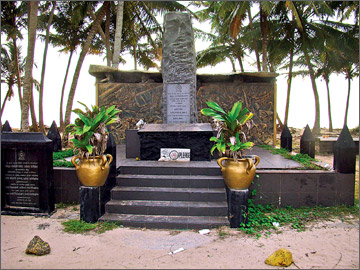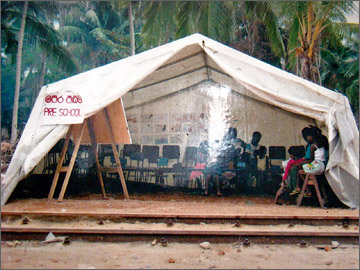That fateful day
Sixth anniversary of the tsunami tragedy :
Yasaratne Gamage in Pereliya
Another day has dawned recalling the
past memories of the worst ever tragedy in Sri Lanka: a series of waves
grabbed everything away from the coastal community just four years ago.
Tsunami turned the Sri Lankan life dramatically in 2004. The word,
originated from Japanese - tsu for 'port' and nami for wave - obviously
became a terrifying word in the world within a few hours
Sri Lanka was known as the Pearl of the Indian Ocean and it took only
half an hour to become a drop of tear. Being the last Poya of 2004, it
was a peaceful and quiet morning. Most citizens were attending religious
ceremonies and celebrating Christmas. The nightmare was yet to come.
|

A train damaged by the tidal wave |
|

Rebuilding the scattered city |
The 'queen of the sea' was in locomotion as usual which left Colombo
for Matara when suddenly it halted at Pereliya as water surged around it
and hundreds of villagers climbed on the train to avoid the mishap but
the huge wave at over five metres smashed the queen against the trees
and houses along the track and fate had no mercy for those who were in
the train almost 1800 people.
Yes it is the worst ever train disaster in the world. The magnificent
beach which attracted thousands of visitors, became a mass grave in no
less than 30 minutes.
Daily News recently visited Peraliya; the flattened village is
rebuilt thanks to the dauntless courage of the survived and those who
took the catastrophe as bone chilling.
Jayanthi recalled the traumatic experience:
"We saw people running towards Telwatte temple (towards the inner
village) shouting and yelling at others that the sea was high tiding.
We had never heard of Tsunami. So we ran along with others to the
temple. Then after some time there was another wave. We managed to cross
the bridge but some couldn't because the roaring mass of water crushed
the bridge and many were carried away into the boundless sea."
Manju, a fisherman by profession, expressed how he saved his sister
but wept for his mother who went on a never-returning journey. "The sea
was strange in the early morning, I felt that intuitively. I told mother
to be careful, I thought it was a high tide. The first wave was about
six feet high, I lifted mother to the roof. My sister and I tried
holding whatever we could grab to stop being floated away, and then I
saw the second wave rushing towards the land. I floated with the water
and didn't lose my sister. We held steadfastly on to a coconut tree.
Poor mother, I couldn't save her."
Sumith lost his wife and three children to the tidal wave. He was not
in a mood to recall that fatal day - he was full of sorrow. He wished
even an enemy would not experience such disaster.
Hundreds and thousands of villagers underwent tragedies of similar
type, but inquiries only made them sadder even with the lapse of six
years.
|

Tsunami monument |
Peraliya, on that fateful day, was a mass of wreckage. One day later
collapsed houses, walls, trees, broken furniture - everything from nail
to bulk demolished - the rail track weirdly twisted were one common
hellish sight.
But that didn't last long. Armed Forces, along with volunteers
organizations, got into work. Roads were cleared and camps were set up
to nurse the shocked and homeless villagers. Non Governmental
Organizations (NGOs) too joined the operation.
A massive appeal through all media awakened the public in all parts
of the country and the Government and private organizations acted
immediately to help victims.
Temples and other religious places became collecting places for aids,
which were dispatched to those in need. People and various organizations
flocked together in delivering and distributing raisins.
A lot of volunteers from other countries too were on board. Health
volunteers took care of hygiene with the maximum support of the hospital
staffs.
The government provided dry raisins while the electricity and water
supply was mended. NGOs, private donors, volunteers all worked hand in
hand to bring life back to normalcy.
|

A school in a camp |
It took almost a year to be able to run the usual routine of the
village. Fishermen started their engines.
Those living within the 100 metre coastal area left the village and
settled in other cities. Some of them were gone forever. Pereliya had
two sub divisions: north and south. There were 235 and165 families
respectively in them. Now only 235 families live in both the divisions.
The Government allocated Rs 1.6 million annually to initiate the
infrastructure. In 2010 Rs 1 m has been granted. The road system was
completely renovated and common facilities were developed gradually.
The school, the one-time refugee camp, was face lifted slowly with
new buildings attached.
Still there are a few remains of houses abandoned by the dwellers
that seem like symbols of the tragedy.
The Tsunami monument, an impressionistic sculpture which has become a
landmark for Peraliya, is visited by many as a respect to the victims.
It is the place for the survivors to ease their sigh and recall all
those who said goodbye without reason. |



